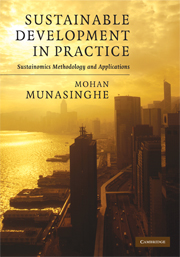Book contents
- Frontmatter
- Contents
- Foreword by James Gustave Speth
- Preface
- Part I Framework and fundamentals
- Part II Global and transnational applications
- Part III National and macroeconomic applications
- 7 National economy-wide applications
- 8 Mathematical macromodel applications
- 9 Computable general equilibrium modelling applications
- Part IV Sub-national sectoral and system applications
- Part V Project and local applications
- References
- Index
8 - Mathematical macromodel applications
Published online by Cambridge University Press: 05 August 2012
- Frontmatter
- Contents
- Foreword by James Gustave Speth
- Preface
- Part I Framework and fundamentals
- Part II Global and transnational applications
- Part III National and macroeconomic applications
- 7 National economy-wide applications
- 8 Mathematical macromodel applications
- 9 Computable general equilibrium modelling applications
- Part IV Sub-national sectoral and system applications
- Part V Project and local applications
- References
- Index
Summary
This chapter expands on the generic results of Chapter 7, by exploring two different theoretical approaches to making development more sustainable at the national macroeconomic level. In Section 8.1, we review the literature on the relationship between optimization and sustainability in growth models (see also Section 2.3). Section 8.2 describes the debate on the costs and benefits of economic growth, and outlines methods for making growth models more sustainomics compatible. In Sections 8.3 and 8.4, such a mathematical model is developed to examine the conditions under which development paths focusing on optimal economic growth might also be made more sustainable. The model is numerically solved using stylized data and the results are analysed. The second case is developed, in Sections 8.5 and 8.6, around a theoretical model, which looks at the circumstances that may justify the use of second-best adjustments to macroeconomic policies, in order to counteract economic distortions that cause serious environmental harm. Three case studies of Botswana, Ghana and Morocco show how macroeconomic polices might harm the environment, and appropriate remedial measures are discussed.
Optimal growth models and sustainable development
The economic dimension of sustainable development (e.g. GNP growth) has long been pursued as a major objective. Traditional development based on growth theory has relied on the paradigm of economic efficiency and dynamic optimality. Growth models that optimize economic output are unable to guarantee sustainability (especially environmental and social).
- Type
- Chapter
- Information
- Sustainable Development in PracticeSustainomics Methodology and Applications, pp. 243 - 268Publisher: Cambridge University PressPrint publication year: 2009



